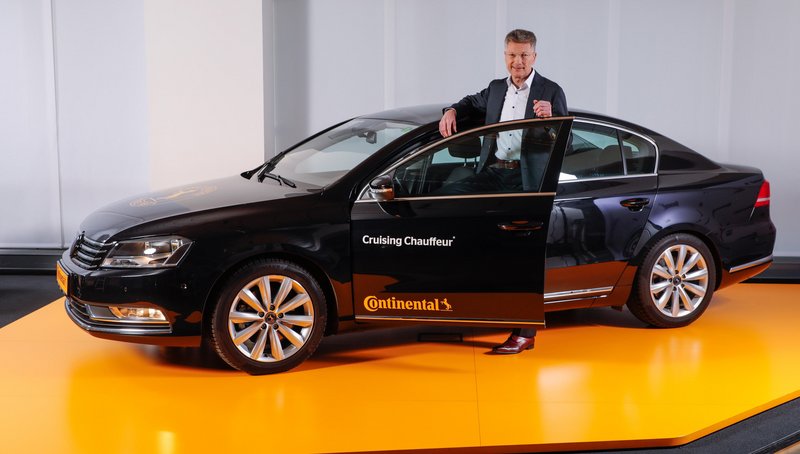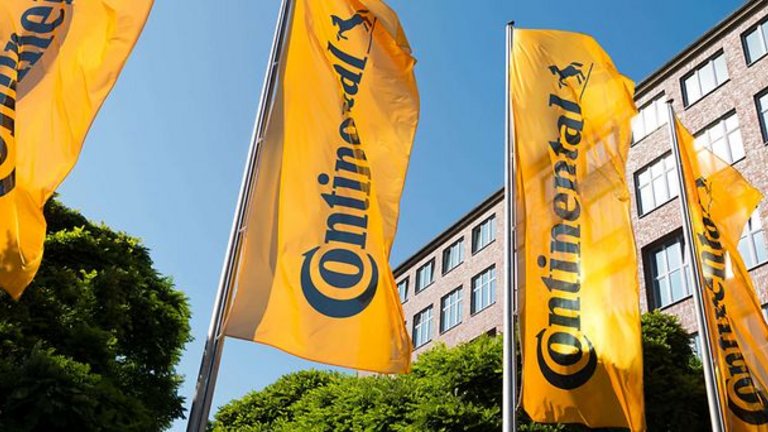On Track for Technological and Financial Success: Continental Is Shaping the Digital Future of Mobility
- CEO Degenhart: “In the future, we will increasingly earn money with mobility services”
- Sales up 3.4 percent to €40.5 billion in 2016
- Net income improved to €2.8 billion / €14.01 per share
- Executive Board proposal: Dividend to rise by 50 cents to €4.25
- Order Intake for advanced driver assistance systems in 2016 worth over €3 billion
- Investments of more than €1 billion into electric mobility over the past years
Hanover, March 2, 2017. In fiscal 2016, the technology company Continental comfortably achieved and in some cases slightly exceeded its annual targets as adjusted in the fall. The company also set the course for profitable growth in the future: “Today we are developing and producing trendsetting technologies for transporting people and their goods. In the future, we will increasingly earn money with mobility services,” said Dr. Elmar Degenhart, Continental’s chairman of the Executive Board, at the presentation of the preliminary figures for fiscal 2016 in Hanover on Thursday. “The automotive industry is undergoing a transformation. The same applies to our business model. Seldom before has there been such an exciting and promising time to shape the mobility of the future,” he added.
Continental continued its streak of successful business years in fiscal 2016. Sales were up 3 percent to €40.5 billion and the adjusted EBIT margin came to 10.8 percent. “With a profit after taxes of €2.8 billion and earnings per share of €14.01, we once again slightly exceeded the previous year’s impressive figures. We again grew faster than the underlying markets for our business,” said Degenhart. In view of the negative effects published in the third quarter, this was an encouraging development, he said. “Without these isolated events, we would have achieved a record year. Our overall success is therefore more than impressive and is intended to pay off for our shareholders, too. We are therefore proposing an increase in the dividend for the fifth time in a row to €4.25,” emphasized Degenhart.
Degenhart believes that the automotive supplier, tire manufacturer, and industrial partner is ideally equipped for the future: “Continental has a sound financial basis and a strong technological position. We are fit for the future.” He said that although the environment was becoming more challenging in economic and political terms, the start to the new year had confirmed the company’s expectations for 2017.
“We anticipate an increase in sales to more than €43 billion. This would mean growing faster than the market again. We want to achieve an adjusted EBIT margin of more than 10.5 percent, in spite of a significant increase in raw material prices,” announced Degenhart. With regard to global vehicle production, Continental anticipates growth of 1 percent to just under 94 million units. The company expects that increases in production in China and Europe and stabilizing sales markets in Brazil and Russia will more than compensate for the slight decline in growth on the American market.
Technology leadership in advanced driver assistance systems extended further
Continental has further extended its leading position in the rapidly growing market for advanced driver assistance systems, achieving incoming orders worth more than €3 billion with related sensor technology and software in 2016. On a cumulative basis, the technology company has invested around €1 billion in development this technology and software over the past five years: “Our goal is to make road accidents a thing of the past for future generations. Advanced driver assistance systems are already helping to protect millions of road users around the world from accidents and their consequences. With the further development of key sensor technologies for better vehicle surroundings monitoring, we will take a big step toward more automation and safety in road traffic,” explained Degenhart.
For example, the company is working on making 3D Flash LIDAR technology ready for production. In a similar way to an echo sounding, this technology uses laser pulses to deliver a highly accurate and distortion-free map of the surroundings. Continental intends to start making this highly efficient technology available for mass production of vehicles from 2020. This step represents a crucial requirement for the market launch of automated and autonomous driving.
Clean, intelligent, and connected vehicles are the future
“By 2050, more than two-thirds of all people are expected to be living in cities. Rough estimates indicate that the majority of the vehicles in these cities will then be operated by mobility service providers and fleet managers. They will probably have an electric drive system, be fully connected, and drive autonomously. This gives rise to new, additional business areas for us. In addition to today’s products, Continental’s core business will therefore also include smart mobility services in the future,” explained Degenhart.
Continental was already among the front-runners in the field of electric mobility, he said. “Over the past years, we have invested more than €1 billion in electric mobility. We are currently working on orders from all of the world’s major markets. But a leap forward in battery technology is still required before the major breakthrough. We do not expect this to happen before 2024, however, and perhaps even a few years later,” said Degenhart.
Continental sees trendsetting changes in the field of intelligent interconnectivity of mobility. In the future, vehicles will communicate more with each other and with infrastructure. For example, Continental has used smart interconnectivity of road data and vehicle data to bring about a reduction of 390 million liters in the amount of diesel consumed by trucks worldwide since 2012.
Direct communication between vehicles and their drivers will help avoid even more accidents in the future. Before the end of 2017, Continental will start production of an interior camera that will help vehicles to detect whether the driver is noticing relevant information and reacting accordingly.
Further increase in sales and net income
Continental CFO Wolfgang Schäfer was generally satisfied with the preliminary results for the year: “As announced, we increased our sales over the course of 2016. We also increased our net income again despite the negative effects announced in October.” Various different matters, including warranty cases, had a negative impact totaling €480 million on profitability in 2016.
1 Before changes in the scope of consolidation.
2 Before amortization of intangible assets from purchase price allocation (PPA), changes in the scope of consolidation, and special effects.
3 Excluding trainees.
4 Subject to the approval of the Annual Shareholders’ Meeting on April 28, 2017.
Click here for key figures for the Continental Corporation - jpg (69KB) .
Sales climbed by more than €1.3 billion, or 3.4 percent, to €40.5 billion. Organic sales growth, i.e. adjusted for changes in the scope of consolidation and exchange rate effects, came to 4.7 percent.
At €4.1 billion, EBIT in fiscal 2016 remained at a similar level to the previous year. The EBIT margin came to 10.1 percent after 10.5 percent in 2015.
Adjusted EBIT, adjusted for changes in the scope of consolidation, acquisition-related amortization, and special effects, amounted to €4.3 billion in 2016, corresponding to a margin of 10.8 percent of adjusted sales. This was lower than the previous year’s figure of €4.4 billion, which represented 11.1 percent of adjusted sales in 2015.
Increased research and development expenses reflect transformation in the automotive industry
Continental invested €2.6 billion in property, plant and equipment, and software in 2016. The capital expenditure ratio thus amounted to 6.4 percent after 5.6 percent in the previous year. Research and development expenses rose by 14.8 percent year-on-year to more than €2.8 billion, corresponding to 6.9 percent of sales after 6.2 percent in the previous year.
“The automotive industry is undergoing a transformation. We are among the front-runners when it comes to new, intelligent mobility concepts and services. The higher requirements for software for this result in more development expenses, but these are offset by lower investments in property, plant and equipment. Past experience has shown that this does not have a negative impact on our earnings margins in the Automotive Group and that the resulting value creation increases,” explained Schäfer.
As at the end of 2016, Continental had liquidity reserves totaling €6 billion, consisting of cash and cash equivalents of €2.1 billion and committed, unutilized credit lines totaling €3.9 billion. This represented an increase in liquidity of €762 million in comparison to the end of 2015. “The available funds give us flexibility and a strong capacity to react to changes,” added Schäfer.
The positive business performance also resulted in a growing number of employees: At the end of 2016, the technology company employed more than 220,000 people, roughly 12,000 more than at the end of 2015. In addition to a rise in production, this increase was due in particular to acquisitions.











